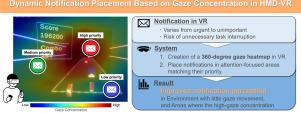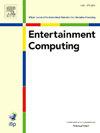HMD-VR中基于注视集中的动态通知放置
IF 2.4
3区 计算机科学
Q2 COMPUTER SCIENCE, CYBERNETICS
引用次数: 0
摘要
虚拟现实(VR)为用户提供身临其境的体验,但事实证明,即使在虚拟现实活动中,用户也经常需要来自外部世界的消息和通知。然而,当通知阻碍了重要的视觉区域或位于用户注意力区域之外时,不适当的通知位置可能导致不必要的任务中断和信息过载。为了解决这一问题,本研究提出了一个系统,该系统可以在不同的凝视集中水平下动态安排通知,以评估VR中的最佳放置策略。该系统利用眼球追踪技术生成360度热图,识别用户的注意力集中在哪里。然后将通知放置在三个不同的凝视集中水平(第20、55和85百分位),以检查放置靠近注意区域的影响。我们进行了一项实验来评估通知放置对用户体验的影响。结果表明,在凝视运动受限的环境中,高凝视区域的定位通知增强了可见度和识别能力。此外,在不同的凝视集中区域,不同的通知位置不会显著影响感知的侵入性、紧迫性、沉浸减少或理解。这些发现表明,视线自适应通知位置可以在不影响用户体验的情况下提高可见性,有助于更有效的VR通知系统。本文章由计算机程序翻译,如有差异,请以英文原文为准。

Dynamic notification placement based on gaze concentration in HMD-VR
Virtual Reality (VR) offers users immersive experiences, but it has been shown that users often need messages and notifications from the outside world even during VR activities. However, inappropriate notification placement can lead to unnecessary task interruptions and information overload when notifications obstruct important visual areas or are positioned outside users’ attention zones. To address this issue, this study proposes a system that dynamically arranges notifications at different gaze concentration levels to evaluate optimal placement strategies in VR. This system utilizes eye-tracking technology to generate a 360-degree heatmap, identifying where users focus their attention. Notifications are then placed at three different gaze concentration levels (20th, 55th, and 85th percentiles) to examine the effects of placement proximity to attention areas. An experiment was conducted to evaluate the impact of notification placement on user experience. Results indicate that in environments with limited gaze movement, positioning notifications in high-gaze areas enhances visibility and recognition. Additionally, varying notification positions across different gaze concentration areas did not significantly affect perceived intrusiveness, urgency, immersion reduction, or comprehension. These findings suggest that gaze-adaptive notification placement can improve visibility without negatively impacting user experience, contributing to more effective VR notification systems.
求助全文
通过发布文献求助,成功后即可免费获取论文全文。
去求助
来源期刊

Entertainment Computing
Computer Science-Human-Computer Interaction
CiteScore
5.90
自引率
7.10%
发文量
66
期刊介绍:
Entertainment Computing publishes original, peer-reviewed research articles and serves as a forum for stimulating and disseminating innovative research ideas, emerging technologies, empirical investigations, state-of-the-art methods and tools in all aspects of digital entertainment, new media, entertainment computing, gaming, robotics, toys and applications among researchers, engineers, social scientists, artists and practitioners. Theoretical, technical, empirical, survey articles and case studies are all appropriate to the journal.
 求助内容:
求助内容: 应助结果提醒方式:
应助结果提醒方式:


